SunVena Solar Blog
Residential Solar News, Insights & Resources
Innovative Solutions for Efficient Hybrid Solar Inverter Integration into Modern Energy Systems
 As the world increasingly shifts towards sustainable energy solutions, the integration of hybrid solar inverters into modern energy systems emerges as a pivotal innovation. These advanced devices not only optimize energy generation by combining solar power with other energy sources but also enhance grid stability and resilience.
As the world increasingly shifts towards sustainable energy solutions, the integration of hybrid solar inverters into modern energy systems emerges as a pivotal innovation. These advanced devices not only optimize energy generation by combining solar power with other energy sources but also enhance grid stability and resilience.
The future of efficient energy systems hinges on leveraging hybrid solar inverters to transition away from traditional fossil fuels towards a more sustainable and renewable energy landscape. By harnessing cutting-edge technologies and smart energy management strategies, we can unlock the full potential of hybrid solar inverters, leading to a more reliable, economical, and environmentally friendly energy future.
This blog will explore the innovative solutions that enable this integration and the promising prospects it holds for both residential and commercial applications.
Advantages of Hybrid Solar Inverters in Modern Energy Landscapes
Hybrid solar inverters are revolutionizing how we harness solar energy, providing distinct advantages in modern energy landscapes.
One of the primary benefits is their ability to efficiently manage multiple energy sources, including solar panels, batteries, and the grid.
This versatility allows for greater energy resilience, ensuring that users can optimize energy consumption and reduce reliance on fossil fuels.
As the demand for clean energy grows, hybrid solar inverters emerge as a vital component in achieving sustainability goals.
Tip:
When considering a hybrid solar inverter, assess your energy needs and the capacity of your current solar system.
This evaluation will help you choose the right inverter model that aligns with both your energy consumption patterns and future expansion plans.
Another significant advantage of hybrid solar inverters is their ability to provide uninterrupted power supply during outages.
By integrating battery storage, these inverters can store excess energy generated during sunny days and utilize it during power shortages.
This feature not only enhances energy security but also contributes to lower electricity bills by maximizing the use of self-generated energy.
Tip:
For optimal performance, ensure your hybrid solar inverter is equipped with smart monitoring features.
This technology allows you to track energy production and consumption in real-time, facilitating informed decisions about energy use and storage.

Enhancing Energy Efficiency through Hybrid Inverter Integration
The integration of hybrid solar inverters into modern energy systems is pivotal for enhancing energy efficiency. Recent industry reports indicate that hybrid inverter technology can increase overall energy utilization by 30% compared to traditional systems. This efficiency boost arises from the inverter's ability to manage multiple energy sources, including solar, grid, and stored battery energy, effectively optimizing their use. As the demand for renewable energy continues to surge, transitioning to hybrid systems is not just a trend but a necessity for sustainable energy futures.

Tip: Optimize Your Energy Sources
To maximize the benefits of hybrid inverters, consider monitoring your energy consumption patterns. Use smart meters or energy management systems to identify peak usage times and adjust your energy sources accordingly. This can significantly reduce reliance on grid power and increase the usage of solar energy throughout the day.
Moreover, the adoption of hybrid solar inverters ensures more consistent power supply and can lower energy bills for consumers. According to market research, households utilizing hybrid systems could see a reduction in energy costs by up to 40%. This integration reflects a broader trend towards decentralized energy production, which is not only cost-effective but also pivotal in mitigating climate change impacts.
Tip: Regular Maintenance is Key
To maintain the efficiency of your hybrid solar inverter system, schedule regular maintenance checks. Clean the solar panels, inspect electrical connections, and ensure that the inverter is functioning optimally. This proactive approach will help in sustaining high energy efficiency over time.
Versatility and Flexibility: Key Benefits of Hybrid Solar Inverters
Hybrid solar inverters represent a significant advancement in the integration of
renewable energy sources into modern energy systems. Their
versatility and flexibility are unparalleled, making them an
ideal choice for various applications ranging from residential to commercial setups. These inverters
seamlessly combine multiple energy sources such as solar panels, batteries, and the grid, allowing users to
optimize energy consumption and reduce reliance on traditional fossil fuels.
This adaptability not only enhances energy security but also
paves the way for a smoother transition towards a more
sustainable energy future.
One of the most compelling benefits of hybrid solar inverters is their ability to operate in different
modes, depending on the energy demands and availability. For instance, during peak sunlight hours, they can efficiently convert solar energy
into electricity while simultaneously charging batteries for later use. Additionally, in times of low solar
production or increased demand, these inverters can tap into stored energy or the grid, ensuring a constant power supply.
This capability significantly improves energy management, making hybrid solar inverters an
essential component for anyone looking to maximize efficiency and sustainability in their energy systems.
Cost Savings and Economic Benefits of Adopting Hybrid Inverters
The transition to hybrid solar inverters represents a groundbreaking shift in modern energy systems, driven largely by their cost-saving potential. Unlike traditional systems, hybrid inverters can seamlessly integrate multiple energy sources, such as solar panels and battery storage, allowing users to optimize their energy consumption and reduce reliance on the grid. This flexibility not only results in lower energy bills but also reduces the need for expensive peak demand charges, ultimately enhancing overall economic efficiency for homeowners and businesses alike.
By adopting hybrid inverters, users can also benefit from government incentives aimed at boosting renewable energy adoption. These incentives can significantly offset the initial investment costs, making the transition more accessible. Furthermore, the ability of hybrid inverters to store excess energy generated during the day for use at night means that consumers can take advantage of off-peak rates and insulate themselves from fluctuations in energy prices. As more individuals and organizations recognize the economic benefits of hybrid inverter technology, the trend towards a sustainable energy future will only continue to gain momentum.
Cost Savings and Economic Benefits of Adopting Hybrid Inverters
Evaluating the Environmental Impact of Hybrid Solar Technology
The integration of hybrid solar inverter technology into modern energy systems offers significant potential for enhancing energy efficiency and reducing environmental impacts. As governments worldwide prioritize renewable energy initiatives, hybrid solar systems present a viable solution by combining traditional solar energy with other renewable sources, such as hydropower. This synergy not only optimizes energy generation but also contributes to a remarkable reduction in greenhouse gas emissions, aligning with global net-zero targets.
The market for solar technologies, including solar simulators and photovoltaic panel cleaning robots, is poised for substantial growth. With estimates projecting the solar simulator market to reach over $8 billion by 2025 and the photovoltaic panel cleaning robot market to grow from $0.75 billion to $2.4 billion by 2030, the demand for efficient solar solutions is clear. These innovations are essential in supporting the widespread adoption of solar technology, advancing sustainability, and minimizing environmental footprints. As the hybrid solar landscape continues to evolve, it's crucial to evaluate and optimize these technologies to ensure their longevity and effectiveness in modern energy systems.
Innovative Solutions for Efficient Hybrid Solar Inverter Integration into Modern Energy Systems - Evaluating the Environmental Impact of Hybrid Solar Technology
| Dimension | Data Point | Impact Assessment | Notes |
|---|---|---|---|
| Energy Conversion Efficiency | 95% | High efficiency reduces energy waste | Optimal for residential use |
| Carbon Emission Reduction | 20 tons CO2/year | Significantly lowers carbon footprint | Compared to conventional systems |
| Installation Cost | $1,200 | Moderate initial investment | Long-term savings on energy bills |
| Lifespan | 25 years | Durable and reliable | Regular maintenance required |
| Return on Investment (ROI) | 15% | Attractive financial return | Over 10 years lifespan |
Related Posts
-

Innovative Examples of RV Solar Inverter Technologies Shaping Sustainable Travel
-

Unlocking Energy Independence with Solar Power Inverter for Home Benefits
-

Mastering Your Solar System with the Best Must Solar Inverter Selection Guide
-

Navigating Import and Export Certifications for Best on Grid Solar Inverters in the Global Market
-

Mastering Your 3kw Solar Inverter Setup A Step by Step Tutorial for Beginners
-

Mastering Hybrid Solar Inverters: A Comprehensive Guide to Boosting Energy Efficiency by 30%